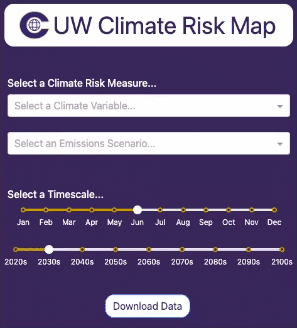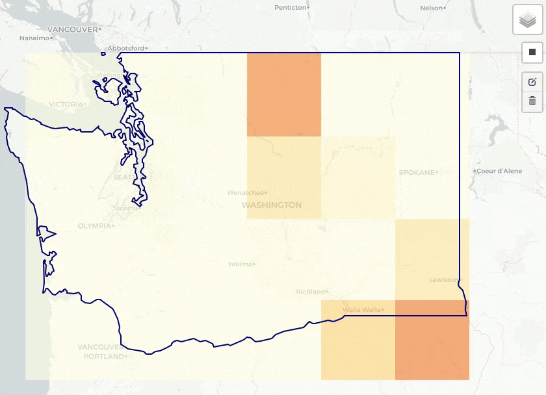CRL Map
Welcome to the Climate Risk Map!
This guide will help you get started with using the tool to understand climate-related hazards and their impacts on physical assets. Whether you're new to climate data or an experienced analyst, this guide will walk you through the basics so you can start exploring climate risk insights right away.
<img src=https://www.climateriskwiki.uw.edu/images/5/5b/CRL_Map_2024-10-09_at_2.53.52_PM.png alt="Climate Risk Map Overview" style="max-width: 100%; height: auto; border-radius: 10px; box-shadow: 0 4px 12px rgba(0, 0, 0, 0.1);">
Figure 1: Climate Risk Map Overview
Overview
“40 years ago, the US experienced a billion-dollar disaster every four months. Today, we experience a billion-dollar disaster every three weeks."
Climate change carries significant financial risks to Washington state businesses and local communities, and we need to rapidly develop open-source tools and resources to help decision-makers adapt.
Purpose
The Climate Risk Map was built with this urgency in mind. As climate-related hazards increase in both frequency and severity, the need for transparent, data-driven tools to assess and mitigate risks has never been more critical. The platform's primary purpose is to equip decision-makers with the insights necessary to understand the financial impacts of climate on infrastructure and assets, allowing for more resilient planning and resource allocation.
Objectives
- Generate Actionable Insights for Climate Risk: Deliver detailed, asset-level risk data that allow users to evaluate infrastructure exposure and vulnerability to climate hazards over different time horizons, supporting informed planning and risk management.
- Facilitate Strategic Adaptation and Resilience: Provide long-term climate risk projections under various scenarios to guide resource prioritization and adaptation strategies for public and private stakeholders, enhancing resilience across sectors.
- Ensure Transparency and Accessibility: Develop an easily accessible open-source platform that offers transparency into data sources, methodologies, and models. This approach promotes trust, regulatory alignment, and collaboration, while serving the needs of academic, government, and industry users.
By meeting these objectives, the Climate Risk Map seeks to bridge the gap between climate science and practical, real-world decision-making, ensuring that all sectors have the necessary information to build resilience against future climate challenges.
Roadmap Summary
The Climate Risk Map is in its early stages of development, and our journey will unfold in multiple phases as we build out the platform’s capabilities. We are just getting started, and our vision is to continuously evolve the platform, responding to the needs of stakeholders and advancing our understanding of climate risks.
We are laying the groundwork for the platform by building its core components and integrating open-source datasets, such as key climate hazards, infrastructure data, and economic metrics. This phase is about establishing a solid base that future capabilities can grow upon.
This phase focuses on expanding the platform’s data quality with higher resolution hazard data and validated, comprehensive physical-asset data. We aim to make this data easily accessible with API access.
Introduce advanced analytics capabilities to provide more sophisticated assessments of climate risks. This includes scenario analysis features, enhanced financial risk metrics, and additional visualizations that enable stakeholders to better understand and prepare for climate-related impacts.
The Climate Risk Map is in its early stages of development, and our vision is to continuously evolve the platform. We aim to respond to the needs of stakeholders and advance our understanding of climate risks over time. This roadmap is intended to be flexible, adapting as new challenges, data, and community input shape the project’s direction.
Community Engagement
Community engagement is an integral part of the Climate Risk Map’s development. Our goal is to collaborate closely with public, private, and academic stakeholders to ensure that the platform effectively serves the diverse needs of its users. We are committed to fostering an open-source community where contributors can help validate models, provide local insights, and enhance platform functionality. By involving the community, we aim to make the Climate Risk Map a shared, evolving resource that is relevant, transparent, and impactful.
Quick-Start Guide
Follow this step-by-step guide for a basic overview of the map functionality. The map can be accessed here.
Selecting Climate Scenario Parameters
First, we need to select a combination of parameters for the desired climate scenario.
The example on the right illustrates a scenario where the selected measure is "% Area Covered by Burnt Vegetation"—used as a proxy for wildfire risk—under a moderate emissions projection for August in the 2060s.
|
Selecting Infrastructure Overlays
Second, we need to select the specific types of infrastructure we are interested in visualizing.
|
Download Data
From here, you can explore the map and your particular areas of interest visually to get a sense of asset exposure. You may wish to download the data to do an offline analysis, which can be done easily.
|
Download Data Output
Below is an example of the data structure you might see when you download the CSV file from the Climate Risk Map. For a full list of fields and their descriptions in the download, see TO DO.
| OSM ID | OSM Subtype | County Name | Tags | SSP | Month | Decade | Climate Variable | Climate Exposure |
|---|---|---|---|---|---|---|---|---|
| 41543109 | Line | Douglas County | {'name': 'Grand Coulee-Chief Joseph No 3', 'power': 'line', 'cables': '3', 'voltage': '500000', 'operator': 'Bonneville Power Administration'} | 370 | 8 | 2060 | Burnt Fraction All | 0.945 |
| 41543169 | Line | Douglas County | {'power': 'line'} | 370 | 8 | 2060 | Burnt Fraction All | 1.445 |
| 41543169 | Line | Grant County | {'power': 'line'} | 370 | 8 | 2060 | Burnt Fraction All | 1.445 |
| 40531749 | Line | Douglas County | {'power': 'line'} | 370 | 8 | 2060 | Burnt Fraction All | 2.435 |
| 40531749 | Line | Grant County | {'power': 'line'} | 370 | 8 | 2060 | Burnt Fraction All | 1.689 |
Methodology
This section provides an overview of how the Climate Risk Mapping Application is built and the methodology behind its calculations and data processing.
Data Sources
Climate
- % Area that is Covered by Burnt Vegetation: This initial variable for the prototype is sourced from CMIP6 (Coupled Model Intercomparison Project Phase 6), which provides multiple scenarios of future climate conditions.


